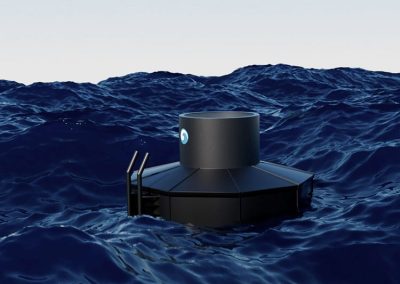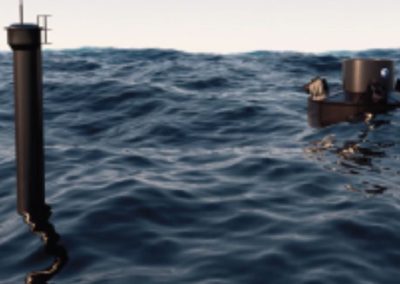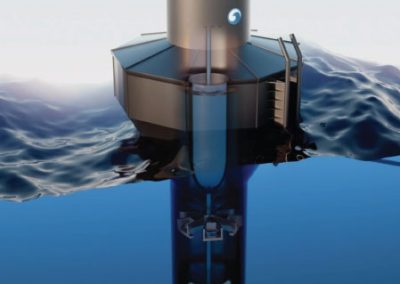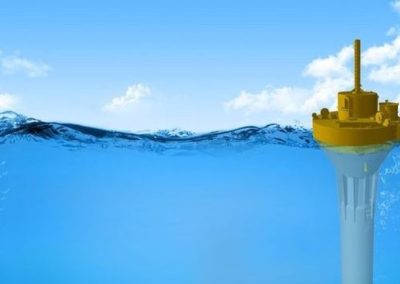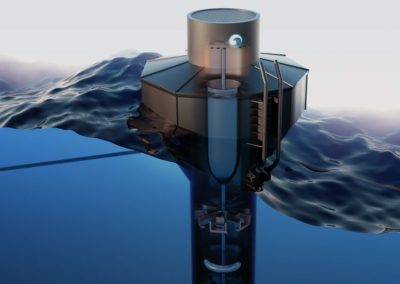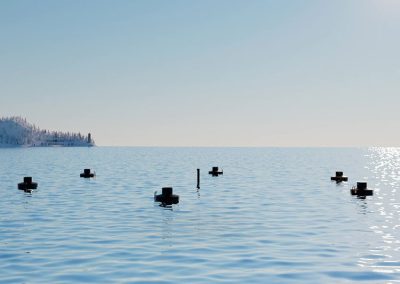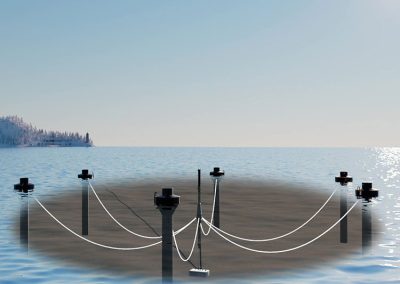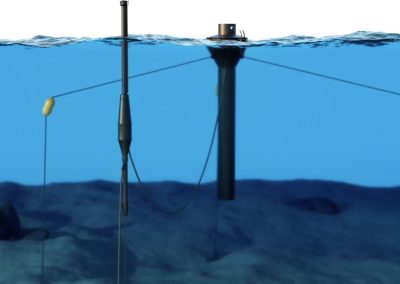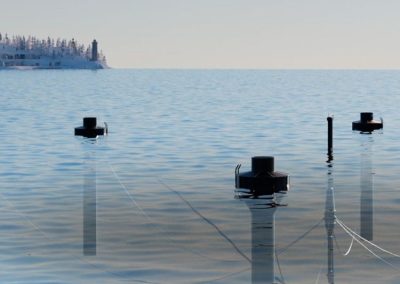
The WaveEL™ System
The Waves4Power WaveEL™ system is based on many years of experience, testing, and marine service operations. The heart of the wave power system is our point absorber; the WaveEL™ buoy, where the power of the waves is converted into electricity.
Unlike most point absorbers, WaveEL™ is self-reacting and does not require a bottom fix on the seabed, making it totally unaffected by tidal variations. Instead, the buoys float freely in the ocean and moorings are used only to keep the buoys on station, allowing the system to handle very large wave and load variations.
As waves rise and fall, the buoy with the attached acceleration tube will move slightly out of phase with the water column in the open acceleration tube. By placing a water piston – connected to a hydraulic/electric conversion system – in the tube, a gigantic pump is created which converts the wave motion to grid quality electricity.
A WaveEL™ systems consists of one or many clusters of six buoys connected to a hub from which the power is exported via medium to high voltage sea cable to the receiver of the power.

The Concept
The WaveEL™ concept is based on three simple but important features - survivability, serviceability, and profitability.
Survivability. Anyone familiar with the harsh, ocean environment knows that survival is hard but is an obvious necessity for a successful operation. The trick to survive is riding the waves, not fighting them. By building small buoys in relation to the length of the waves in which they work, you ensure the odds of survival are on your side.
Serviceability require accessibility. With all serviceable components above water and with ease to board the buoy from small boats or large vessels alike, service can be performed safely, efficiently and without the need of divers. All connections on the WaveEL™ buoy as well as the WaveEL™ Hub are dry with no need for expensive “Wet Mate” connections.
Profitability, the third key feature for future success of the WaveEL™ system hinges on four easily defined – but not as easily obtained – parameters that determine the cost of the power produced. They are the manufacturing cost, the cost of launch and retrieval, the maintenance cost during the life of the device, and finally the system efficiency or output.
The cost of building a wave power device is much dependent on the amount of raw material needed. For this reason, the parameter kWh produced per unit of weight, have lately become a key factor in comparing different systems. The WaveEL™ buoy is different by having one of the highest outputs per unit of weight [kWh/year/kg] known in the industry.
Waves4Power has showed the feasibility of using smaller devices. Ease of handling during deployment as well as Wave4Power’s unique logistics approach from start to finish ensures that these, “small” units are perfectly suited for mass production and deployment. Cost of operation and maintenance during the 25-year lifetime of the device, must be considered in the final cost calculations. Waves4Power’s focus on survivability, serviceability, modular design, and use of well-tested, standard components make for minimized operation and maintenance costs and for a profitable operation.
Our Technology
The WaveEL™ buoy is the power converter.
The standard WaveEL™ buoy is eight meters in diameter, in the water line. A vertical tube – 3.5 meters in diameter – passes through the buoy centre, reaching down 28 – 38 meters below the surface. Inside the tube is a water piston attached to a hydraulic system, and power take-off system, which convert the wave-induced, up and down motion to electricity. The electric power is exported via a patented low-voltage cable to the WaveEL™ Hub where it is transformed to medium high voltage and sent via sea cable to the power user.
The WaveEL™ buoy is moored with poly ropes to heavy gravity anchors on the ocean floor. The mooring design gives the buoy freedom to move almost unimpeded vertically, while safely securing it on station.
- The Wave4Power WaveEL™ system is a point absorber equally suitable in coastal areas and offshore.
- WaveEL™ 3.0 has been proven in long-term (12,000 hrs.) full-scale prototype studies in relevant environment on the Norwegian coast.
- WaveEL™ 4.0 was introduced in 2023 and is going commercial in 2024.
- WaveEL™ is designed to use off-the-shelf components from well-known suppliers, reducing development efforts, lowering costs, and simplifying scalability.
- Waves4Power has developed unique patented solutions to advance its innovative technology with a focus on survival, low cost, and scalability.
- WaveEL™ has an advantage over its peers with a high ratio of installed power per unit of weight [kW/kg]
- Waves4Power has a clear, substantial, and proven value proposition for various external stakeholders.

Power Resource
The theoretical potential of energy from wave is high, with an estimated capacity of around 29,500 TWh per year, compared to 1,200 TWh for tidal.
This means wave energy alone could theoretically meet all global energy demand”, says Francesco La Camera, Director-General at IRENA1.
“The main advantage of ocean energies is that they can help stabilize the electricity system because they don’t suffer the same kind of variability as solar and wind.”
Continues Francesco La Camera.
1 IRENA the International Renewable Energy Agency
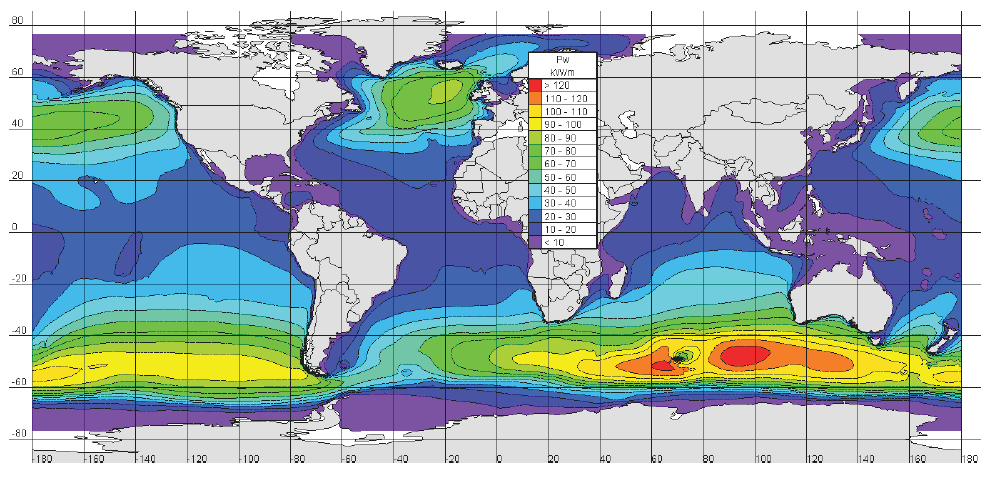
The power that never ends
The world needs free, clean, greenhouse gas (GHG) energy. Electric power consumption by 2050 is estimated at 3 times today’s level. All possible sustainable energy sources need to be developed. Wave power has the potential to supply the world’s energy needs many times over. Every day, the ocean waves are charged with at least 9901 times more energy than the world requires. It’s the only energy source using power from the sun that has not yet been commercialized. The wave energy – like solar and wind energy – is free for anyone to use. It has the potential to eliminate all need for power from fossil fuel.
1 According to the Swedish utility Vattenfall
Global Projects
Waves4Power is currently involved in several interesting client development projects, as well as continued system development. Below we present some of our project opportunities: Southeast Asia, South Africa, and USA. Naturally, we are also active in developing projects in Europe with an initial focus on Norway and UK.
Southeast Asia
From Spring 2021 to Spring 2023, Waves4Power has been part of BAPI (Business Acceleration Project Indonesia). This project was initiated by The Swedish Energy Agency and run by Business Sweden has resulted in an MOU with PLN Indonesia Power, in December 2022, and an MOU with PLN Nusantara Power, on June 23. The first pilot project, 3 MW installed power, under these MOUs is expected in 2024.
Several more projects for power generation with scale-up opportunity to +100MW, are in the pipeline. Waves4Power has also, in December 2022, signed a MOU with Sembcorp Singapore (sembcorp.com), regarding strategic partnership and market development in Southeast Asia and the Pacific. The day-to-day business in Indonesia is managed by our local representative, PT Bina Muda Teknikatama, Mr Firdaus Wajdi.
South Africa
In South Africa, our local representative, Africa Gateway International, has started an EIAS (Environmental Impact Assessment Study) to lay the foundation for the first WaveEL™ pilot contract in the Western Cape Province. The EIAS is planned to be ready in Q3, 2024 and the first pilot contract is expected later in the year. Our partner is also exploring the possibility to start local fabrication and assembly of the WaveEL™ system in South Africa.
USA
Launch Alaska
Following a competitive global application process, Waves4Power was among 21 companies selected for Launch Alaska’s 2023 Tech Deployment Track.
Launch Alaska is a non-profit, technology, deployment accelerator, focused on decarbonizing systems of energy, transportation, and industry. Its Tech Deployment Track is designed to help companies forge partnerships and identify projects in Alaska. An eight-month deployment accelerator program, the Tech Deployment Track pairs climate tech companies with Alaskan partners and customers to help determine whether a product or service is viable for deployment in Alaska.
When the program kicked off in Anchorage, in September 2023, Waves4Power presented its green energy wave power technology to a curated group of volunteer advisors for invaluable feedback. Over the coming months, we will work alongside Alaskan partners to vet and develop partnership and project opportunities in communities around the state. Successful program graduates will end with a variety of promising, in-progress projects and an invitation to join the Launch Alaska Portfolio with continued support and connections to opportunities in Alaska.
For more information, visit Launch Alaska.
Strategic Partnership, E2
Since 2021, Waves4Power has been active in the Energy Two (E2) ecosystem of companies. Speed to market is important to reach our goal and to secure the first contracts in the United States. Being part of the E2 ecosystem of companies will help in accelerating our speed, not the least in the U.S. markets. Working together will also help the funding needed to reach our common goals.
